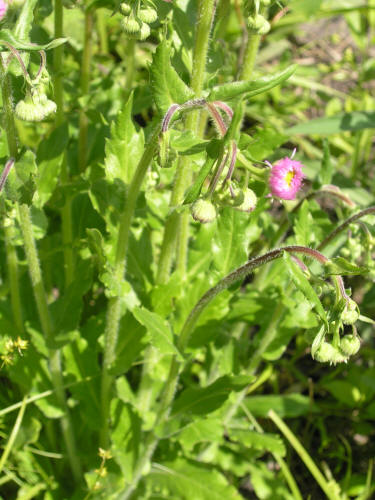Philadelphia Fleabane
Philadelphia Fleabane
Erigeron philadelphicus L.
Asteraceae (Aster Family)
▲ colony of flowering plants

▲ ▼ flowers/inflorescences


▲ illustration of how stems supporting flower heads tend to droop over before inflorescence clusters open

▲ ▼ stems and leaves, showing hairy stems and leaf bases that clasp around the stem

▲ ▼ stems and leaves, showing hairy stems and leaf bases that clasp around the stem
Erigeron philadelphicus L., Philadelphia Fleabane, Marsh Fleabane: (Bayer Code: ERIPH; US Code ERPH)
- Native biennial or short-lived perennial plant that grows 1-3 feet tall with ridged, green, usually hairy stems; stems usually single until flowering commences
- Leaves first form a basal rosette of oblanceolate leaves with toothed margins and pointed tips; as the flowering stem elongates, the rosette leaves often wither
- Stem leaves more closely spaced toward base of stem than in upper stem and are oblanceolate, lanceolate to triangular, and all have bases that partially clasp around stem
- Flower head inflorescences are in loose clusters at tips of flowering stems, with individual heads about 0.5 to 1 inch diameter, usually flowering from mid-spring through summer (although some plants may be found in flower throughout growing season)
- Flower heads have over 100 ray (“petal") flowers that are pale pink to white (deeper pink to bluish in cultivated forms of this species) that surround a nearly-flattened disk of yellow disk flowers--flowers can be quite showy
- Bracts below the inflorescence are green, lanceolate, with upward-pointing (rough) hairs, and they form a broad, funnel-shaped base below the head
- Found in more moist soils--open woods, prairies, urban areas, right-of-ways, disturbed sites, non-crop areas; is sometimes cultivated as a landscape flower
- Similar species include:
- Rough Fleabane (Erigeron strigosus) has narrower leaves, more widely spaced on the stems, rough-textured hairs on leaf undersides and slightly smaller flower heads
- Daisy Fleabane (Erigeron annuus) has larger basal leaves and stem leaves, more stem leaves along flowering stem, and more and slightly larger flower heads, plus much of the plant is covered with soft, spreading hairs
- White Heath Aster (Symphyotrichum pilosum) is also similar, but it is a perennial, is often much-branched throughout the plant, with short, linear to needle-like leaves in upper stem branches, and flower heads arise from leaf axils; individual flower heads have fewer, slightly wider ray (“petal") flowers, and the disk is raised more to almost spherical, and the color can be yellow to rust-brown or red; white heath aster also flowers in late summer through autumn. (Other asters, Symphyotrichum spp., differ from fleabanes in their general flower shape as described above.)